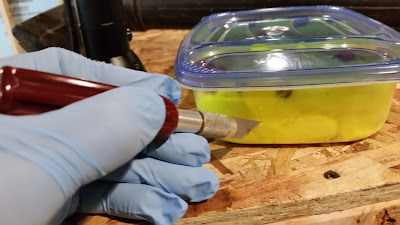After a relaxing vacation in Michigan and down south with family in Kentucky we came home to find our mouse problem on the rise.
The traps around the basement had caught one while we were gone and another mouse a couple of days after our return. This situation leaves me pondering one very important question, "Where are they getting in" ??? I had already constructed a curtain wall around the worst parts of the foundation. I had replaced the old broken basement windows. It's time to change up the plan a little.
What ever shall I do?
I think I'll start feeding the mice and perhaps in return they will cooperate and tell me how they are getting into the house. Maybe they will also tell me where they are going once inside and if they happen to have a nest somewhere? Does that sound so crazy? Maybe my kids have subjected me to too much Mickey Mouse Clubhouse... oh Toodles!
A plan was hatched, no mousekatools required.
Before we started crating our dog we would use a black light flashlight to find urine spots. I tried the same with mouse urine but it wasn't detectable. However, I found some very bright florescent dust on amazon and thought it would leave a nice trail if I could somehow get the mouse coated in it.
Dust, food container, grass seed (bait).
It reacts nice and bright with the black light.
I thought I could impregnate some cotton balls with the dust as a transfer medium.
Shaking them in a bag worked out nice and didn't use much dust at all.
Now somehow I have to get them to take the cotton balls (for nesting material) and / or crawl through them.
Some aromatic chocolates and dried strawberries were added as bait.
It's become apparent that any further interaction with this stuff will require gloves and should probably be done outside.
It's become apparent that any further interaction with this stuff will require gloves and should probably be done outside.
Two entry holes were cut into the container on the opposite side from where most of the bait was.
It's a bit messy.
The whole contraption was placed directly in the crawl space.
There it is with the black light on it.
It's good at leaving an invisible mess.
I hope I don't find something nasty at the end of the trail like a large nest or this guy:
He just wanted the chocolates!...and maybe your skull.
I'm going to let the bait sit until the weekend and see if there are any other trails or areas of interest. After that I'll probably have to get in the crawl space and dig out some insulation to see if I can identify an entry point.




















































